This pipeline computes the correlation between cancer subtypes identified by different molecular patterns and selected clinical features.
Testing the association between subtypes identified by 3 different clustering approaches and 17 clinical features across 100 patients, 3 significant findings detected with P value < 0.05 and Q value < 0.25.
-
Consensus hierarchical clustering analysis on array-based mRNA expression data identified 5 subtypes that do not correlate to any clinical features.
-
CNMF clustering analysis on methylation data identified 4 subtypes that correlate to 'HISTOLOGICAL_TYPE'.
-
7 subtypes identified in current cancer cohort by 'METHYLATION CHIERARCHICAL'. These subtypes correlate to 'HISTOLOGICAL_TYPE' and 'RADIATION_THERAPY'.
Table 1. Get Full Table Overview of the association between subtypes identified by 3 different clustering approaches and 17 clinical features. Shown in the table are P values (Q values). Thresholded by P value < 0.05 and Q value < 0.25, 3 significant findings detected.
|
Clinical Features |
Statistical Tests |
mRNA cHierClus subtypes |
Methylation CNMF subtypes |
METHYLATION CHIERARCHICAL |
| DAYS TO DEATH OR LAST FUP | logrank test |
0.412 (0.83) |
0.818 (0.909) |
0.585 (0.847) |
| HISTOLOGICAL TYPE | Fisher's exact test |
0.713 (0.909) |
0.0012 (0.0306) |
0.00011 (0.00561) |
| FIGO GRADE | Fisher's exact test |
0.315 (0.81) |
0.027 (0.344) |
0.472 (0.83) |
| KARNOFSKY PERFORMANCE SCORE | Kruskal-Wallis (anova) |
0.526 (0.838) |
0.0369 (0.377) |
0.133 (0.519) |
| MSI | Fisher's exact test |
0.574 (0.847) |
1 (1.00) |
0.479 (0.83) |
| PATHOLOGY T STAGE | Fisher's exact test |
0.108 (0.459) |
0.148 (0.519) |
0.584 (0.847) |
| PATHOLOGY N STAGE | Fisher's exact test |
0.386 (0.83) |
0.818 (0.909) |
0.45 (0.83) |
| PATHOLOGIC STAGE | Fisher's exact test |
0.36 (0.83) |
0.488 (0.83) |
0.484 (0.83) |
| YEARS TO BIRTH | Kruskal-Wallis (anova) |
0.517 (0.838) |
0.82 (0.909) |
0.47 (0.83) |
| ETHNICITY | Fisher's exact test |
0.28 (0.792) |
0.0768 (0.426) |
0.844 (0.909) |
| RACE | Fisher's exact test |
0.849 (0.909) |
0.364 (0.83) |
0.266 (0.792) |
| RADIATION THERAPY | Fisher's exact test |
0.919 (0.956) |
0.105 (0.459) |
0.0145 (0.246) |
| DIABETES | Fisher's exact test |
0.83 (0.909) |
0.0655 (0.422) |
0.67 (0.909) |
| BMI | Fisher's exact test |
0.0661 (0.422) |
0.0515 (0.422) |
0.598 (0.847) |
| NUMBER PACK YEARS SMOKED | Kruskal-Wallis (anova) |
0.318 (0.81) |
0.153 (0.519) |
0.0835 (0.426) |
| SMOKER | Fisher's exact test |
0.855 (0.909) |
0.26 (0.792) |
0.734 (0.909) |
| COUNTRY OF ORIGIN | Fisher's exact test |
0.728 (0.909) |
0.679 (0.909) |
0.947 (0.966) |
Table S1. Description of clustering approach #1: 'mRNA cHierClus subtypes'
| Cluster Labels | 1 | 2 | 3 | 4 | 5 |
|---|---|---|---|---|---|
| Number of samples | 28 | 20 | 11 | 20 | 21 |
P value = 0.412 (logrank test), Q value = 0.83
Table S2. Clustering Approach #1: 'mRNA cHierClus subtypes' versus Clinical Feature #1: 'DAYS_TO_DEATH_OR_LAST_FUP'
| nPatients | nDeath | Duration Range (Median), Month | |
|---|---|---|---|
| ALL | 99 | 3 | 0.0 - 130.4 (11.6) |
| subtype1 | 28 | 2 | 5.4 - 24.3 (11.2) |
| subtype2 | 19 | 1 | 0.0 - 23.3 (10.8) |
| subtype3 | 11 | 0 | 1.9 - 23.5 (14.0) |
| subtype4 | 20 | 0 | 6.0 - 130.4 (12.6) |
| subtype5 | 20 | 0 | 6.6 - 24.8 (11.8) |
Figure S1. Get High-res Image Clustering Approach #1: 'mRNA cHierClus subtypes' versus Clinical Feature #1: 'DAYS_TO_DEATH_OR_LAST_FUP'

P value = 0.713 (Fisher's exact test), Q value = 0.91
Table S3. Clustering Approach #1: 'mRNA cHierClus subtypes' versus Clinical Feature #2: 'HISTOLOGICAL_TYPE'
| nPatients | CLEAR CELL CARCINOMA | ENDOMETRIOID CARCINOMA | MIXED CELL ADENOCARCINOMA | SEROUS CARCINOMA |
|---|---|---|---|---|
| ALL | 1 | 77 | 1 | 21 |
| subtype1 | 0 | 22 | 0 | 6 |
| subtype2 | 0 | 15 | 1 | 4 |
| subtype3 | 0 | 10 | 0 | 1 |
| subtype4 | 1 | 13 | 0 | 6 |
| subtype5 | 0 | 17 | 0 | 4 |
Figure S2. Get High-res Image Clustering Approach #1: 'mRNA cHierClus subtypes' versus Clinical Feature #2: 'HISTOLOGICAL_TYPE'

P value = 0.315 (Fisher's exact test), Q value = 0.81
Table S4. Clustering Approach #1: 'mRNA cHierClus subtypes' versus Clinical Feature #3: 'FIGO_GRADE'
| nPatients | FIGO GRADE 1 | FIGO GRADE 2 | FIGO GRADE 3 |
|---|---|---|---|
| ALL | 32 | 34 | 7 |
| subtype1 | 8 | 11 | 2 |
| subtype2 | 5 | 8 | 2 |
| subtype3 | 8 | 1 | 0 |
| subtype4 | 4 | 7 | 1 |
| subtype5 | 7 | 7 | 2 |
Figure S3. Get High-res Image Clustering Approach #1: 'mRNA cHierClus subtypes' versus Clinical Feature #3: 'FIGO_GRADE'

P value = 0.526 (Kruskal-Wallis (anova)), Q value = 0.84
Table S5. Clustering Approach #1: 'mRNA cHierClus subtypes' versus Clinical Feature #4: 'KARNOFSKY_PERFORMANCE_SCORE'
| nPatients | Mean (Std.Dev) | |
|---|---|---|
| ALL | 58 | 91.9 (8.5) |
| subtype1 | 16 | 94.4 (5.1) |
| subtype2 | 13 | 92.3 (9.3) |
| subtype3 | 7 | 90.0 (14.1) |
| subtype4 | 13 | 91.5 (8.0) |
| subtype5 | 9 | 88.9 (7.8) |
Figure S4. Get High-res Image Clustering Approach #1: 'mRNA cHierClus subtypes' versus Clinical Feature #4: 'KARNOFSKY_PERFORMANCE_SCORE'

P value = 0.574 (Fisher's exact test), Q value = 0.85
Table S6. Clustering Approach #1: 'mRNA cHierClus subtypes' versus Clinical Feature #5: 'MSI'
| nPatients | MSI-H | MSI-L | MSS |
|---|---|---|---|
| ALL | 4 | 5 | 23 |
| subtype1 | 1 | 2 | 9 |
| subtype2 | 2 | 1 | 2 |
| subtype3 | 1 | 0 | 4 |
| subtype4 | 0 | 0 | 3 |
| subtype5 | 0 | 2 | 5 |
Figure S5. Get High-res Image Clustering Approach #1: 'mRNA cHierClus subtypes' versus Clinical Feature #5: 'MSI'

P value = 0.108 (Kruskal-Wallis (anova)), Q value = 0.46
Table S7. Clustering Approach #1: 'mRNA cHierClus subtypes' versus Clinical Feature #6: 'PATHOLOGY_T_STAGE'
| T1 | T2 | T3 | |
|---|---|---|---|
| ALL | 78 | 11 | 10 |
| subtype1 | 23 | 1 | 4 |
| subtype2 | 15 | 4 | 1 |
| subtype3 | 9 | 1 | 0 |
| subtype4 | 16 | 0 | 4 |
| subtype5 | 15 | 5 | 1 |
Figure S6. Get High-res Image Clustering Approach #1: 'mRNA cHierClus subtypes' versus Clinical Feature #6: 'PATHOLOGY_T_STAGE'

P value = 0.386 (Kruskal-Wallis (anova)), Q value = 0.83
Table S8. Clustering Approach #1: 'mRNA cHierClus subtypes' versus Clinical Feature #7: 'PATHOLOGY_N_STAGE'
| N0 | N1 | N2 | |
|---|---|---|---|
| ALL | 46 | 6 | 3 |
| subtype1 | 13 | 1 | 0 |
| subtype2 | 12 | 1 | 0 |
| subtype3 | 6 | 0 | 0 |
| subtype4 | 9 | 2 | 1 |
| subtype5 | 6 | 2 | 2 |
Figure S7. Get High-res Image Clustering Approach #1: 'mRNA cHierClus subtypes' versus Clinical Feature #7: 'PATHOLOGY_N_STAGE'

P value = 0.36 (Fisher's exact test), Q value = 0.83
Table S9. Clustering Approach #1: 'mRNA cHierClus subtypes' versus Clinical Feature #8: 'PATHOLOGIC_STAGE'
| nPatients | STAGE I | STAGE IA | STAGE IB | STAGE II | STAGE III | STAGE IV | STAGE IVB |
|---|---|---|---|---|---|---|---|
| ALL | 72 | 1 | 1 | 8 | 15 | 2 | 1 |
| subtype1 | 21 | 0 | 0 | 1 | 5 | 1 | 0 |
| subtype2 | 15 | 0 | 0 | 3 | 2 | 0 | 0 |
| subtype3 | 9 | 0 | 0 | 1 | 0 | 0 | 1 |
| subtype4 | 14 | 1 | 1 | 0 | 3 | 1 | 0 |
| subtype5 | 13 | 0 | 0 | 3 | 5 | 0 | 0 |
Figure S8. Get High-res Image Clustering Approach #1: 'mRNA cHierClus subtypes' versus Clinical Feature #8: 'PATHOLOGIC_STAGE'

P value = 0.517 (Kruskal-Wallis (anova)), Q value = 0.84
Table S10. Clustering Approach #1: 'mRNA cHierClus subtypes' versus Clinical Feature #9: 'YEARS_TO_BIRTH'
| nPatients | Mean (Std.Dev) | |
|---|---|---|
| ALL | 100 | 63.6 (10.1) |
| subtype1 | 28 | 64.6 (12.0) |
| subtype2 | 20 | 65.0 (9.6) |
| subtype3 | 11 | 58.7 (10.2) |
| subtype4 | 20 | 64.3 (10.7) |
| subtype5 | 21 | 62.6 (6.2) |
Figure S9. Get High-res Image Clustering Approach #1: 'mRNA cHierClus subtypes' versus Clinical Feature #9: 'YEARS_TO_BIRTH'
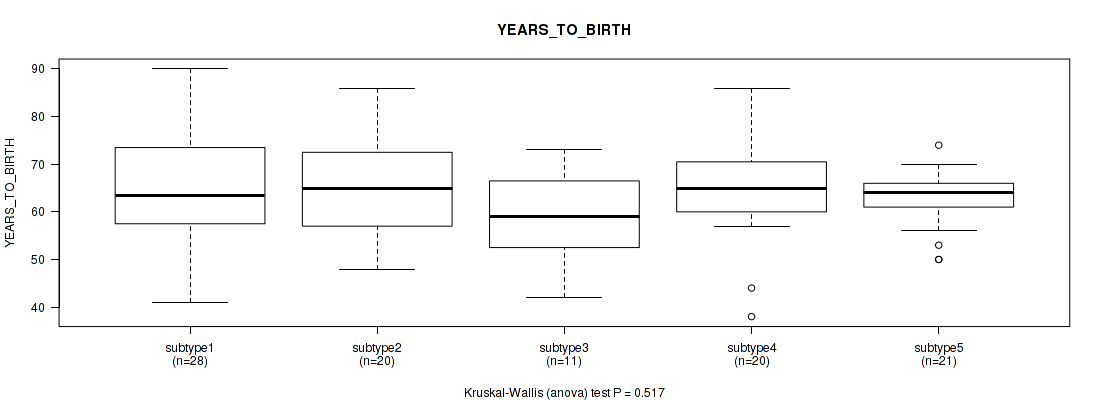
P value = 0.28 (Fisher's exact test), Q value = 0.79
Table S11. Clustering Approach #1: 'mRNA cHierClus subtypes' versus Clinical Feature #10: 'ETHNICITY'
| nPatients | HISPANIC OR LATINO | NOT HISPANIC OR LATINO |
|---|---|---|
| ALL | 4 | 41 |
| subtype1 | 1 | 14 |
| subtype2 | 1 | 7 |
| subtype3 | 0 | 4 |
| subtype4 | 2 | 5 |
| subtype5 | 0 | 11 |
Figure S10. Get High-res Image Clustering Approach #1: 'mRNA cHierClus subtypes' versus Clinical Feature #10: 'ETHNICITY'
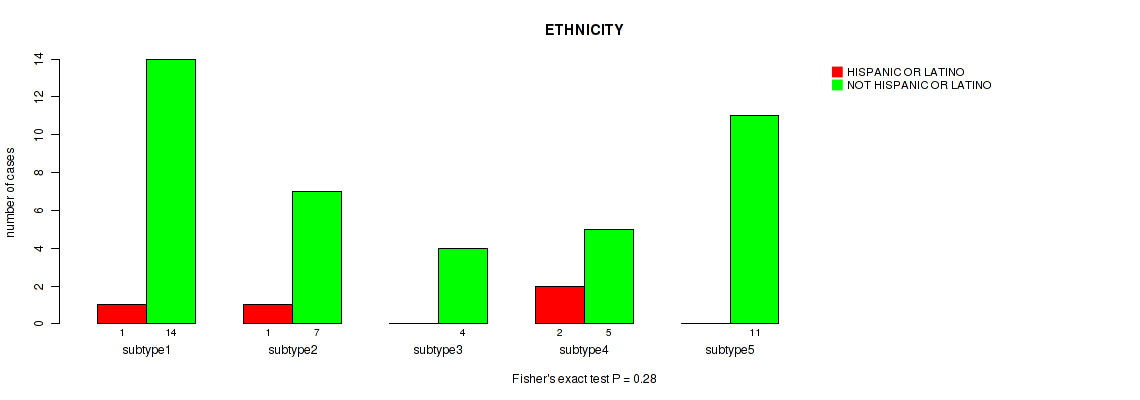
P value = 0.849 (Fisher's exact test), Q value = 0.91
Table S12. Clustering Approach #1: 'mRNA cHierClus subtypes' versus Clinical Feature #11: 'RACE'
| nPatients | ASIAN | BLACK OR AFRICAN AMERICAN | WHITE |
|---|---|---|---|
| ALL | 1 | 3 | 58 |
| subtype1 | 0 | 1 | 19 |
| subtype2 | 0 | 1 | 11 |
| subtype3 | 0 | 0 | 7 |
| subtype4 | 0 | 0 | 11 |
| subtype5 | 1 | 1 | 10 |
Figure S11. Get High-res Image Clustering Approach #1: 'mRNA cHierClus subtypes' versus Clinical Feature #11: 'RACE'

P value = 0.919 (Fisher's exact test), Q value = 0.96
Table S13. Clustering Approach #1: 'mRNA cHierClus subtypes' versus Clinical Feature #12: 'RADIATION_THERAPY'
| nPatients | NO | YES |
|---|---|---|
| ALL | 43 | 54 |
| subtype1 | 11 | 17 |
| subtype2 | 9 | 9 |
| subtype3 | 5 | 6 |
| subtype4 | 8 | 12 |
| subtype5 | 10 | 10 |
Figure S12. Get High-res Image Clustering Approach #1: 'mRNA cHierClus subtypes' versus Clinical Feature #12: 'RADIATION_THERAPY'
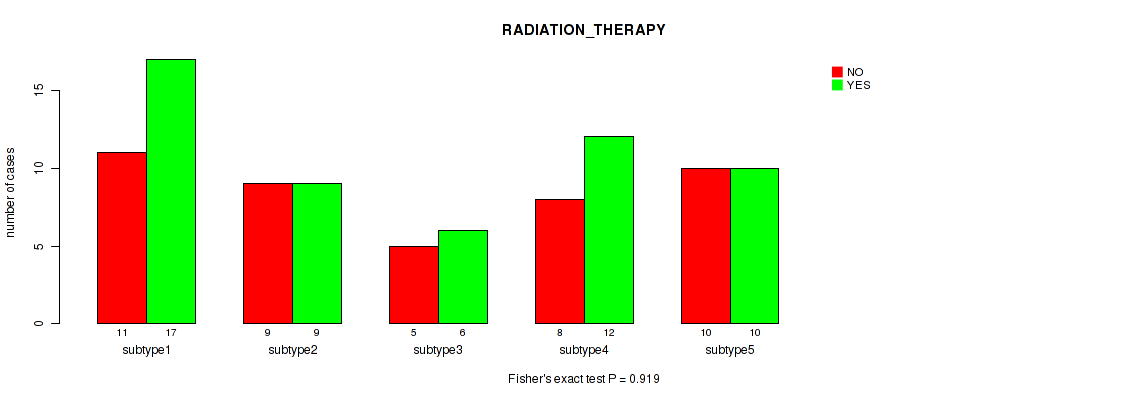
P value = 0.83 (Fisher's exact test), Q value = 0.91
Table S14. Clustering Approach #1: 'mRNA cHierClus subtypes' versus Clinical Feature #13: 'DIABETES'
| nPatients | NO | YES |
|---|---|---|
| ALL | 70 | 28 |
| subtype1 | 22 | 6 |
| subtype2 | 12 | 7 |
| subtype3 | 8 | 3 |
| subtype4 | 14 | 6 |
| subtype5 | 14 | 6 |
Figure S13. Get High-res Image Clustering Approach #1: 'mRNA cHierClus subtypes' versus Clinical Feature #13: 'DIABETES'
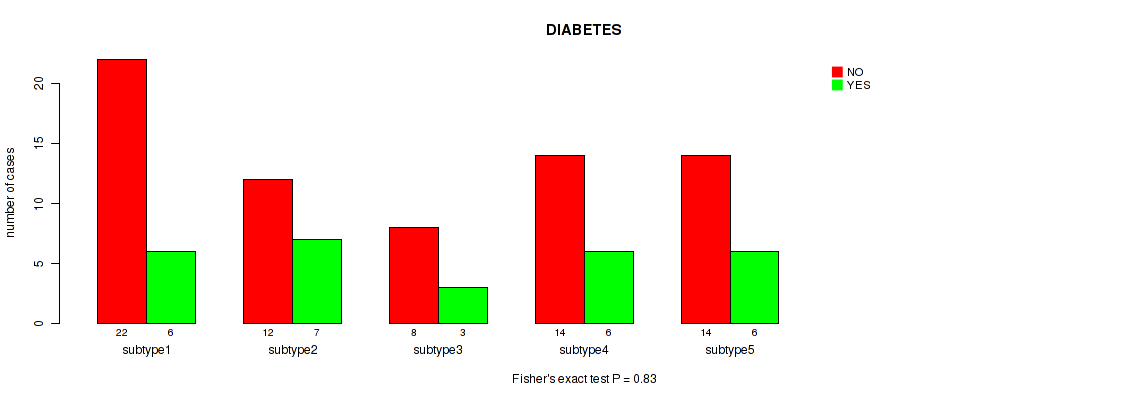
P value = 0.0661 (Fisher's exact test), Q value = 0.42
Table S15. Clustering Approach #1: 'mRNA cHierClus subtypes' versus Clinical Feature #14: 'BMI'
| nPatients | NORMAL | OBESE | OVERWEIGHT | SEVERELY OBESE | UNDERWEIGHT |
|---|---|---|---|---|---|
| ALL | 8 | 47 | 21 | 21 | 3 |
| subtype1 | 5 | 11 | 7 | 3 | 2 |
| subtype2 | 1 | 12 | 1 | 6 | 0 |
| subtype3 | 0 | 5 | 2 | 3 | 1 |
| subtype4 | 0 | 8 | 9 | 3 | 0 |
| subtype5 | 2 | 11 | 2 | 6 | 0 |
Figure S14. Get High-res Image Clustering Approach #1: 'mRNA cHierClus subtypes' versus Clinical Feature #14: 'BMI'

P value = 0.318 (Kruskal-Wallis (anova)), Q value = 0.81
Table S16. Clustering Approach #1: 'mRNA cHierClus subtypes' versus Clinical Feature #15: 'NUMBER_PACK_YEARS_SMOKED'
| nPatients | Mean (Std.Dev) | |
|---|---|---|
| ALL | 18 | 14.5 (11.9) |
| subtype1 | 5 | 21.6 (18.7) |
| subtype2 | 4 | 13.3 (8.6) |
| subtype3 | 3 | 4.5 (4.4) |
| subtype4 | 4 | 12.6 (7.5) |
| subtype5 | 2 | 17.8 (2.5) |
Figure S15. Get High-res Image Clustering Approach #1: 'mRNA cHierClus subtypes' versus Clinical Feature #15: 'NUMBER_PACK_YEARS_SMOKED'
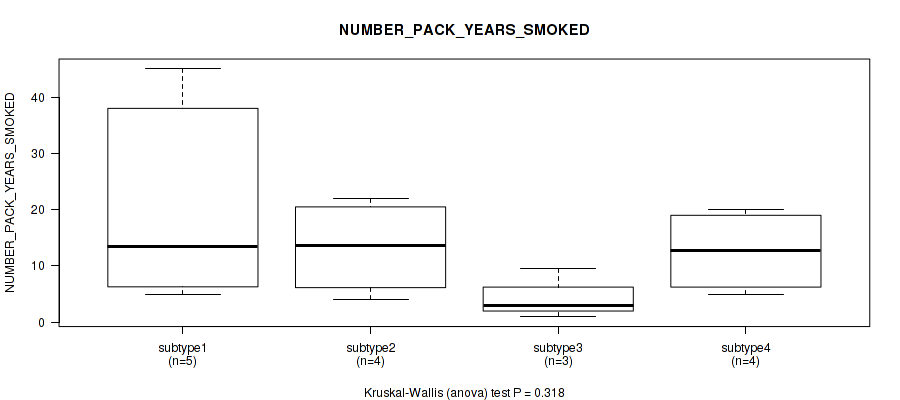
P value = 0.855 (Fisher's exact test), Q value = 0.91
Table S17. Clustering Approach #1: 'mRNA cHierClus subtypes' versus Clinical Feature #16: 'SMOKER'
| nPatients | NON-SMOKER | SMOKER |
|---|---|---|
| ALL | 73 | 22 |
| subtype1 | 21 | 6 |
| subtype2 | 12 | 4 |
| subtype3 | 7 | 4 |
| subtype4 | 16 | 4 |
| subtype5 | 17 | 4 |
Figure S16. Get High-res Image Clustering Approach #1: 'mRNA cHierClus subtypes' versus Clinical Feature #16: 'SMOKER'
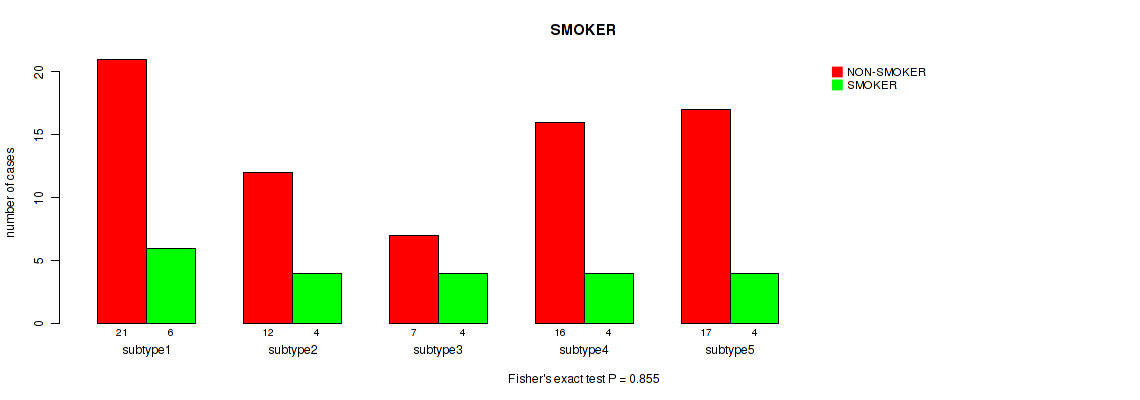
P value = 0.728 (Fisher's exact test), Q value = 0.91
Table S18. Clustering Approach #1: 'mRNA cHierClus subtypes' versus Clinical Feature #17: 'COUNTRY_OF_ORIGIN'
| nPatients | MEXICO | POLAND | UKRAINE | UNITED STATES |
|---|---|---|---|---|
| ALL | 2 | 5 | 32 | 36 |
| subtype1 | 0 | 0 | 8 | 12 |
| subtype2 | 1 | 1 | 6 | 4 |
| subtype3 | 0 | 1 | 3 | 4 |
| subtype4 | 1 | 2 | 7 | 6 |
| subtype5 | 0 | 1 | 8 | 10 |
Figure S17. Get High-res Image Clustering Approach #1: 'mRNA cHierClus subtypes' versus Clinical Feature #17: 'COUNTRY_OF_ORIGIN'

Table S19. Description of clustering approach #2: 'Methylation CNMF subtypes'
| Cluster Labels | 1 | 2 | 3 | 4 |
|---|---|---|---|---|
| Number of samples | 35 | 33 | 16 | 12 |
P value = 0.818 (logrank test), Q value = 0.91
Table S20. Clustering Approach #2: 'Methylation CNMF subtypes' versus Clinical Feature #1: 'DAYS_TO_DEATH_OR_LAST_FUP'
| nPatients | nDeath | Duration Range (Median), Month | |
|---|---|---|---|
| ALL | 95 | 3 | 1.9 - 130.4 (11.6) |
| subtype1 | 34 | 1 | 6.1 - 130.4 (11.6) |
| subtype2 | 32 | 1 | 2.3 - 24.3 (10.9) |
| subtype3 | 16 | 1 | 1.9 - 24.8 (11.4) |
| subtype4 | 12 | 0 | 9.6 - 22.9 (14.5) |
Figure S18. Get High-res Image Clustering Approach #2: 'Methylation CNMF subtypes' versus Clinical Feature #1: 'DAYS_TO_DEATH_OR_LAST_FUP'

P value = 0.0012 (Fisher's exact test), Q value = 0.031
Table S21. Clustering Approach #2: 'Methylation CNMF subtypes' versus Clinical Feature #2: 'HISTOLOGICAL_TYPE'
| nPatients | CLEAR CELL CARCINOMA | ENDOMETRIOID CARCINOMA | MIXED CELL ADENOCARCINOMA | SEROUS CARCINOMA |
|---|---|---|---|---|
| ALL | 1 | 77 | 1 | 17 |
| subtype1 | 0 | 33 | 0 | 2 |
| subtype2 | 1 | 24 | 1 | 7 |
| subtype3 | 0 | 8 | 0 | 8 |
| subtype4 | 0 | 12 | 0 | 0 |
Figure S19. Get High-res Image Clustering Approach #2: 'Methylation CNMF subtypes' versus Clinical Feature #2: 'HISTOLOGICAL_TYPE'

P value = 0.027 (Fisher's exact test), Q value = 0.34
Table S22. Clustering Approach #2: 'Methylation CNMF subtypes' versus Clinical Feature #3: 'FIGO_GRADE'
| nPatients | FIGO GRADE 1 | FIGO GRADE 2 | FIGO GRADE 3 |
|---|---|---|---|
| ALL | 32 | 34 | 7 |
| subtype1 | 15 | 14 | 3 |
| subtype2 | 10 | 12 | 0 |
| subtype3 | 0 | 4 | 3 |
| subtype4 | 7 | 4 | 1 |
Figure S20. Get High-res Image Clustering Approach #2: 'Methylation CNMF subtypes' versus Clinical Feature #3: 'FIGO_GRADE'

P value = 0.0369 (Kruskal-Wallis (anova)), Q value = 0.38
Table S23. Clustering Approach #2: 'Methylation CNMF subtypes' versus Clinical Feature #4: 'KARNOFSKY_PERFORMANCE_SCORE'
| nPatients | Mean (Std.Dev) | |
|---|---|---|
| ALL | 55 | 92.7 (7.6) |
| subtype1 | 17 | 92.4 (7.5) |
| subtype2 | 25 | 94.4 (8.7) |
| subtype3 | 9 | 88.9 (3.3) |
| subtype4 | 4 | 92.5 (5.0) |
Figure S21. Get High-res Image Clustering Approach #2: 'Methylation CNMF subtypes' versus Clinical Feature #4: 'KARNOFSKY_PERFORMANCE_SCORE'

P value = 1 (Fisher's exact test), Q value = 1
Table S24. Clustering Approach #2: 'Methylation CNMF subtypes' versus Clinical Feature #5: 'MSI'
| nPatients | MSI-H | MSI-L | MSS |
|---|---|---|---|
| ALL | 4 | 5 | 23 |
| subtype1 | 1 | 2 | 8 |
| subtype2 | 1 | 1 | 7 |
| subtype3 | 1 | 1 | 5 |
| subtype4 | 1 | 1 | 3 |
Figure S22. Get High-res Image Clustering Approach #2: 'Methylation CNMF subtypes' versus Clinical Feature #5: 'MSI'

P value = 0.148 (Kruskal-Wallis (anova)), Q value = 0.52
Table S25. Clustering Approach #2: 'Methylation CNMF subtypes' versus Clinical Feature #6: 'PATHOLOGY_T_STAGE'
| T1 | T2 | T3 | |
|---|---|---|---|
| ALL | 75 | 11 | 9 |
| subtype1 | 27 | 5 | 3 |
| subtype2 | 28 | 3 | 1 |
| subtype3 | 9 | 3 | 4 |
| subtype4 | 11 | 0 | 1 |
Figure S23. Get High-res Image Clustering Approach #2: 'Methylation CNMF subtypes' versus Clinical Feature #6: 'PATHOLOGY_T_STAGE'

P value = 0.818 (Kruskal-Wallis (anova)), Q value = 0.91
Table S26. Clustering Approach #2: 'Methylation CNMF subtypes' versus Clinical Feature #7: 'PATHOLOGY_N_STAGE'
| N0 | N1 | N2 | |
|---|---|---|---|
| ALL | 44 | 5 | 2 |
| subtype1 | 15 | 1 | 1 |
| subtype2 | 16 | 3 | 0 |
| subtype3 | 9 | 1 | 1 |
| subtype4 | 4 | 0 | 0 |
Figure S24. Get High-res Image Clustering Approach #2: 'Methylation CNMF subtypes' versus Clinical Feature #7: 'PATHOLOGY_N_STAGE'

P value = 0.488 (Fisher's exact test), Q value = 0.83
Table S27. Clustering Approach #2: 'Methylation CNMF subtypes' versus Clinical Feature #8: 'PATHOLOGIC_STAGE'
| nPatients | STAGE I | STAGE IA | STAGE IB | STAGE II | STAGE III | STAGE IV | STAGE IVB |
|---|---|---|---|---|---|---|---|
| ALL | 70 | 1 | 1 | 8 | 14 | 1 | 1 |
| subtype1 | 25 | 1 | 0 | 3 | 5 | 1 | 0 |
| subtype2 | 26 | 0 | 0 | 2 | 4 | 0 | 1 |
| subtype3 | 8 | 0 | 1 | 3 | 4 | 0 | 0 |
| subtype4 | 11 | 0 | 0 | 0 | 1 | 0 | 0 |
Figure S25. Get High-res Image Clustering Approach #2: 'Methylation CNMF subtypes' versus Clinical Feature #8: 'PATHOLOGIC_STAGE'

P value = 0.82 (Kruskal-Wallis (anova)), Q value = 0.91
Table S28. Clustering Approach #2: 'Methylation CNMF subtypes' versus Clinical Feature #9: 'YEARS_TO_BIRTH'
| nPatients | Mean (Std.Dev) | |
|---|---|---|
| ALL | 96 | 63.5 (10.2) |
| subtype1 | 35 | 62.6 (8.3) |
| subtype2 | 33 | 63.5 (10.6) |
| subtype3 | 16 | 67.1 (13.4) |
| subtype4 | 12 | 60.9 (8.6) |
Figure S26. Get High-res Image Clustering Approach #2: 'Methylation CNMF subtypes' versus Clinical Feature #9: 'YEARS_TO_BIRTH'

P value = 0.0768 (Fisher's exact test), Q value = 0.43
Table S29. Clustering Approach #2: 'Methylation CNMF subtypes' versus Clinical Feature #10: 'ETHNICITY'
| nPatients | HISPANIC OR LATINO | NOT HISPANIC OR LATINO |
|---|---|---|
| ALL | 4 | 40 |
| subtype1 | 1 | 19 |
| subtype2 | 0 | 8 |
| subtype3 | 3 | 6 |
| subtype4 | 0 | 7 |
Figure S27. Get High-res Image Clustering Approach #2: 'Methylation CNMF subtypes' versus Clinical Feature #10: 'ETHNICITY'
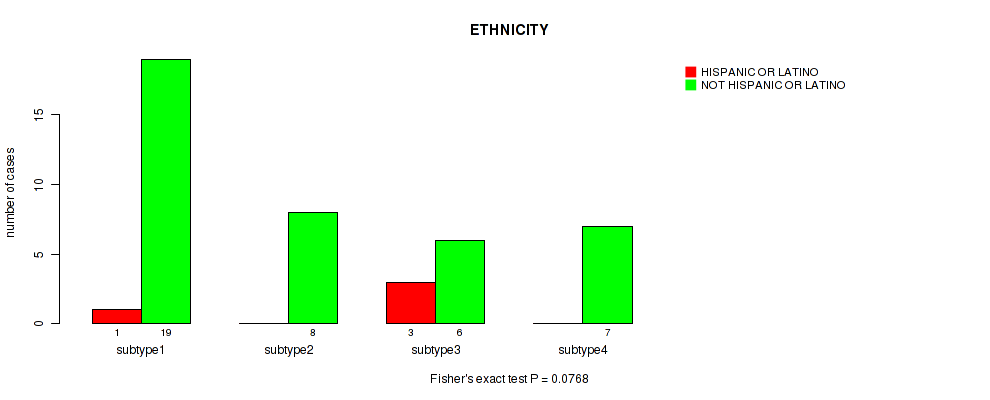
P value = 0.364 (Fisher's exact test), Q value = 0.83
Table S30. Clustering Approach #2: 'Methylation CNMF subtypes' versus Clinical Feature #11: 'RACE'
| nPatients | ASIAN | BLACK OR AFRICAN AMERICAN | WHITE |
|---|---|---|---|
| ALL | 1 | 3 | 57 |
| subtype1 | 0 | 1 | 23 |
| subtype2 | 0 | 1 | 19 |
| subtype3 | 0 | 1 | 8 |
| subtype4 | 1 | 0 | 7 |
Figure S28. Get High-res Image Clustering Approach #2: 'Methylation CNMF subtypes' versus Clinical Feature #11: 'RACE'

P value = 0.105 (Fisher's exact test), Q value = 0.46
Table S31. Clustering Approach #2: 'Methylation CNMF subtypes' versus Clinical Feature #12: 'RADIATION_THERAPY'
| nPatients | NO | YES |
|---|---|---|
| ALL | 43 | 52 |
| subtype1 | 18 | 16 |
| subtype2 | 13 | 20 |
| subtype3 | 4 | 12 |
| subtype4 | 8 | 4 |
Figure S29. Get High-res Image Clustering Approach #2: 'Methylation CNMF subtypes' versus Clinical Feature #12: 'RADIATION_THERAPY'

P value = 0.0655 (Fisher's exact test), Q value = 0.42
Table S32. Clustering Approach #2: 'Methylation CNMF subtypes' versus Clinical Feature #13: 'DIABETES'
| nPatients | NO | YES |
|---|---|---|
| ALL | 68 | 27 |
| subtype1 | 23 | 11 |
| subtype2 | 24 | 9 |
| subtype3 | 15 | 1 |
| subtype4 | 6 | 6 |
Figure S30. Get High-res Image Clustering Approach #2: 'Methylation CNMF subtypes' versus Clinical Feature #13: 'DIABETES'
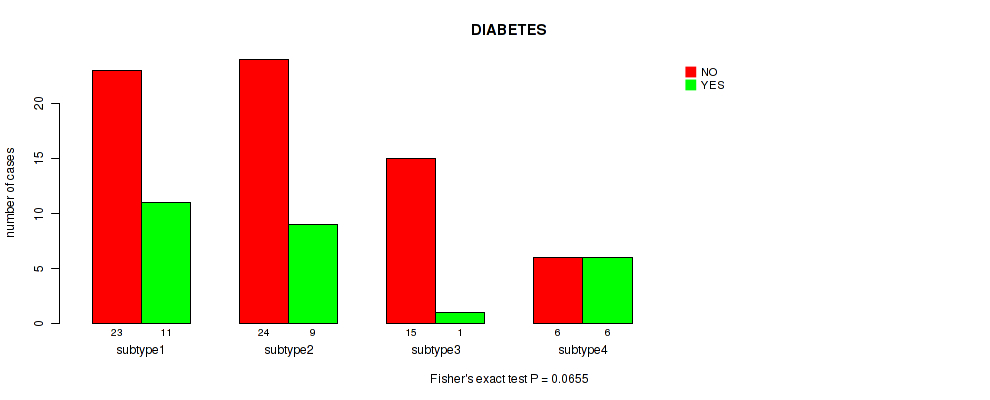
P value = 0.0515 (Fisher's exact test), Q value = 0.42
Table S33. Clustering Approach #2: 'Methylation CNMF subtypes' versus Clinical Feature #14: 'BMI'
| nPatients | NORMAL | OBESE | OVERWEIGHT | SEVERELY OBESE | UNDERWEIGHT |
|---|---|---|---|---|---|
| ALL | 7 | 45 | 20 | 21 | 3 |
| subtype1 | 3 | 12 | 7 | 10 | 3 |
| subtype2 | 1 | 21 | 4 | 7 | 0 |
| subtype3 | 3 | 5 | 7 | 1 | 0 |
| subtype4 | 0 | 7 | 2 | 3 | 0 |
Figure S31. Get High-res Image Clustering Approach #2: 'Methylation CNMF subtypes' versus Clinical Feature #14: 'BMI'

P value = 0.153 (Kruskal-Wallis (anova)), Q value = 0.52
Table S34. Clustering Approach #2: 'Methylation CNMF subtypes' versus Clinical Feature #15: 'NUMBER_PACK_YEARS_SMOKED'
| nPatients | Mean (Std.Dev) | |
|---|---|---|
| ALL | 18 | 14.5 (11.9) |
| subtype1 | 7 | 18.8 (13.2) |
| subtype2 | 9 | 12.0 (11.0) |
| subtype4 | 2 | 10.5 (13.4) |
Figure S32. Get High-res Image Clustering Approach #2: 'Methylation CNMF subtypes' versus Clinical Feature #15: 'NUMBER_PACK_YEARS_SMOKED'

P value = 0.26 (Fisher's exact test), Q value = 0.79
Table S35. Clustering Approach #2: 'Methylation CNMF subtypes' versus Clinical Feature #16: 'SMOKER'
| nPatients | NON-SMOKER | SMOKER |
|---|---|---|
| ALL | 70 | 21 |
| subtype1 | 25 | 9 |
| subtype2 | 20 | 9 |
| subtype3 | 15 | 1 |
| subtype4 | 10 | 2 |
Figure S33. Get High-res Image Clustering Approach #2: 'Methylation CNMF subtypes' versus Clinical Feature #16: 'SMOKER'

P value = 0.679 (Fisher's exact test), Q value = 0.91
Table S36. Clustering Approach #2: 'Methylation CNMF subtypes' versus Clinical Feature #17: 'COUNTRY_OF_ORIGIN'
| nPatients | MEXICO | POLAND | UKRAINE | UNITED STATES |
|---|---|---|---|---|
| ALL | 2 | 3 | 31 | 35 |
| subtype1 | 1 | 2 | 9 | 16 |
| subtype2 | 0 | 1 | 11 | 6 |
| subtype3 | 1 | 0 | 7 | 8 |
| subtype4 | 0 | 0 | 4 | 5 |
Figure S34. Get High-res Image Clustering Approach #2: 'Methylation CNMF subtypes' versus Clinical Feature #17: 'COUNTRY_OF_ORIGIN'

Table S37. Description of clustering approach #3: 'METHYLATION CHIERARCHICAL'
| Cluster Labels | 1 | 2 | 3 | 4 | 5 | 6 | 7 |
|---|---|---|---|---|---|---|---|
| Number of samples | 34 | 11 | 9 | 7 | 6 | 20 | 9 |
P value = 0.585 (logrank test), Q value = 0.85
Table S38. Clustering Approach #3: 'METHYLATION CHIERARCHICAL' versus Clinical Feature #1: 'DAYS_TO_DEATH_OR_LAST_FUP'
| nPatients | nDeath | Duration Range (Median), Month | |
|---|---|---|---|
| ALL | 95 | 3 | 1.9 - 130.4 (11.6) |
| subtype1 | 33 | 0 | 6.1 - 130.4 (11.1) |
| subtype2 | 11 | 1 | 5.4 - 24.3 (13.1) |
| subtype3 | 9 | 1 | 6.7 - 22.4 (17.5) |
| subtype4 | 7 | 0 | 1.9 - 24.8 (22.6) |
| subtype5 | 6 | 0 | 10.4 - 22.9 (17.1) |
| subtype6 | 19 | 1 | 2.3 - 23.5 (9.6) |
| subtype7 | 9 | 0 | 8.2 - 23.3 (14.0) |
Figure S35. Get High-res Image Clustering Approach #3: 'METHYLATION CHIERARCHICAL' versus Clinical Feature #1: 'DAYS_TO_DEATH_OR_LAST_FUP'

P value = 0.00011 (Fisher's exact test), Q value = 0.0056
Table S39. Clustering Approach #3: 'METHYLATION CHIERARCHICAL' versus Clinical Feature #2: 'HISTOLOGICAL_TYPE'
| nPatients | CLEAR CELL CARCINOMA | ENDOMETRIOID CARCINOMA | MIXED CELL ADENOCARCINOMA | SEROUS CARCINOMA |
|---|---|---|---|---|
| ALL | 1 | 77 | 1 | 17 |
| subtype1 | 0 | 32 | 0 | 2 |
| subtype2 | 0 | 3 | 0 | 8 |
| subtype3 | 0 | 9 | 0 | 0 |
| subtype4 | 0 | 4 | 0 | 3 |
| subtype5 | 0 | 6 | 0 | 0 |
| subtype6 | 1 | 15 | 1 | 3 |
| subtype7 | 0 | 8 | 0 | 1 |
Figure S36. Get High-res Image Clustering Approach #3: 'METHYLATION CHIERARCHICAL' versus Clinical Feature #2: 'HISTOLOGICAL_TYPE'

P value = 0.472 (Fisher's exact test), Q value = 0.83
Table S40. Clustering Approach #3: 'METHYLATION CHIERARCHICAL' versus Clinical Feature #3: 'FIGO_GRADE'
| nPatients | FIGO GRADE 1 | FIGO GRADE 2 | FIGO GRADE 3 |
|---|---|---|---|
| ALL | 32 | 34 | 7 |
| subtype1 | 12 | 15 | 4 |
| subtype2 | 0 | 2 | 0 |
| subtype3 | 5 | 3 | 1 |
| subtype4 | 0 | 2 | 1 |
| subtype5 | 4 | 1 | 1 |
| subtype6 | 7 | 7 | 0 |
| subtype7 | 4 | 4 | 0 |
Figure S37. Get High-res Image Clustering Approach #3: 'METHYLATION CHIERARCHICAL' versus Clinical Feature #3: 'FIGO_GRADE'

P value = 0.133 (Kruskal-Wallis (anova)), Q value = 0.52
Table S41. Clustering Approach #3: 'METHYLATION CHIERARCHICAL' versus Clinical Feature #4: 'KARNOFSKY_PERFORMANCE_SCORE'
| nPatients | Mean (Std.Dev) | |
|---|---|---|
| ALL | 55 | 92.7 (7.6) |
| subtype1 | 19 | 90.5 (7.1) |
| subtype2 | 6 | 93.3 (5.2) |
| subtype3 | 3 | 96.7 (5.8) |
| subtype4 | 4 | 90.0 (0.0) |
| subtype5 | 2 | 95.0 (7.1) |
| subtype6 | 16 | 94.4 (10.3) |
| subtype7 | 5 | 94.0 (5.5) |
Figure S38. Get High-res Image Clustering Approach #3: 'METHYLATION CHIERARCHICAL' versus Clinical Feature #4: 'KARNOFSKY_PERFORMANCE_SCORE'

P value = 0.479 (Fisher's exact test), Q value = 0.83
Table S42. Clustering Approach #3: 'METHYLATION CHIERARCHICAL' versus Clinical Feature #5: 'MSI'
| nPatients | MSI-H | MSI-L | MSS |
|---|---|---|---|
| ALL | 4 | 5 | 23 |
| subtype1 | 2 | 3 | 6 |
| subtype2 | 0 | 0 | 5 |
| subtype3 | 0 | 0 | 5 |
| subtype4 | 0 | 0 | 1 |
| subtype5 | 1 | 1 | 0 |
| subtype6 | 1 | 0 | 4 |
| subtype7 | 0 | 1 | 2 |
Figure S39. Get High-res Image Clustering Approach #3: 'METHYLATION CHIERARCHICAL' versus Clinical Feature #5: 'MSI'

P value = 0.584 (Kruskal-Wallis (anova)), Q value = 0.85
Table S43. Clustering Approach #3: 'METHYLATION CHIERARCHICAL' versus Clinical Feature #6: 'PATHOLOGY_T_STAGE'
| T1 | T2 | T3 | |
|---|---|---|---|
| ALL | 75 | 11 | 9 |
| subtype1 | 25 | 6 | 3 |
| subtype2 | 7 | 1 | 3 |
| subtype3 | 8 | 0 | 1 |
| subtype4 | 5 | 1 | 1 |
| subtype5 | 6 | 0 | 0 |
| subtype6 | 17 | 1 | 1 |
| subtype7 | 7 | 2 | 0 |
Figure S40. Get High-res Image Clustering Approach #3: 'METHYLATION CHIERARCHICAL' versus Clinical Feature #6: 'PATHOLOGY_T_STAGE'

P value = 0.45 (Kruskal-Wallis (anova)), Q value = 0.83
Table S44. Clustering Approach #3: 'METHYLATION CHIERARCHICAL' versus Clinical Feature #7: 'PATHOLOGY_N_STAGE'
| N0 | N1 | N2 | |
|---|---|---|---|
| ALL | 44 | 5 | 2 |
| subtype1 | 17 | 1 | 1 |
| subtype2 | 4 | 1 | 1 |
| subtype3 | 2 | 0 | 0 |
| subtype4 | 5 | 0 | 0 |
| subtype5 | 2 | 0 | 0 |
| subtype6 | 9 | 3 | 0 |
| subtype7 | 5 | 0 | 0 |
Figure S41. Get High-res Image Clustering Approach #3: 'METHYLATION CHIERARCHICAL' versus Clinical Feature #7: 'PATHOLOGY_N_STAGE'

P value = 0.484 (Fisher's exact test), Q value = 0.83
Table S45. Clustering Approach #3: 'METHYLATION CHIERARCHICAL' versus Clinical Feature #8: 'PATHOLOGIC_STAGE'
| nPatients | STAGE I | STAGE IA | STAGE IB | STAGE II | STAGE III | STAGE IV | STAGE IVB |
|---|---|---|---|---|---|---|---|
| ALL | 70 | 1 | 1 | 8 | 14 | 1 | 1 |
| subtype1 | 24 | 1 | 0 | 4 | 5 | 0 | 0 |
| subtype2 | 7 | 0 | 0 | 1 | 3 | 0 | 0 |
| subtype3 | 7 | 0 | 0 | 0 | 1 | 1 | 0 |
| subtype4 | 4 | 0 | 1 | 1 | 1 | 0 | 0 |
| subtype5 | 6 | 0 | 0 | 0 | 0 | 0 | 0 |
| subtype6 | 15 | 0 | 0 | 0 | 4 | 0 | 1 |
| subtype7 | 7 | 0 | 0 | 2 | 0 | 0 | 0 |
Figure S42. Get High-res Image Clustering Approach #3: 'METHYLATION CHIERARCHICAL' versus Clinical Feature #8: 'PATHOLOGIC_STAGE'

P value = 0.47 (Kruskal-Wallis (anova)), Q value = 0.83
Table S46. Clustering Approach #3: 'METHYLATION CHIERARCHICAL' versus Clinical Feature #9: 'YEARS_TO_BIRTH'
| nPatients | Mean (Std.Dev) | |
|---|---|---|
| ALL | 96 | 63.5 (10.2) |
| subtype1 | 34 | 61.5 (8.2) |
| subtype2 | 11 | 69.7 (12.0) |
| subtype3 | 9 | 59.6 (13.4) |
| subtype4 | 7 | 68.6 (11.8) |
| subtype5 | 6 | 64.7 (2.3) |
| subtype6 | 20 | 62.8 (12.2) |
| subtype7 | 9 | 63.9 (4.5) |
Figure S43. Get High-res Image Clustering Approach #3: 'METHYLATION CHIERARCHICAL' versus Clinical Feature #9: 'YEARS_TO_BIRTH'

P value = 0.844 (Fisher's exact test), Q value = 0.91
Table S47. Clustering Approach #3: 'METHYLATION CHIERARCHICAL' versus Clinical Feature #10: 'ETHNICITY'
| nPatients | HISPANIC OR LATINO | NOT HISPANIC OR LATINO |
|---|---|---|
| ALL | 4 | 40 |
| subtype1 | 3 | 14 |
| subtype2 | 1 | 4 |
| subtype3 | 0 | 7 |
| subtype4 | 0 | 3 |
| subtype5 | 0 | 4 |
| subtype6 | 0 | 4 |
| subtype7 | 0 | 4 |
Figure S44. Get High-res Image Clustering Approach #3: 'METHYLATION CHIERARCHICAL' versus Clinical Feature #10: 'ETHNICITY'

P value = 0.266 (Fisher's exact test), Q value = 0.79
Table S48. Clustering Approach #3: 'METHYLATION CHIERARCHICAL' versus Clinical Feature #11: 'RACE'
| nPatients | ASIAN | BLACK OR AFRICAN AMERICAN | WHITE |
|---|---|---|---|
| ALL | 1 | 3 | 57 |
| subtype1 | 0 | 1 | 20 |
| subtype2 | 0 | 0 | 7 |
| subtype3 | 0 | 0 | 7 |
| subtype4 | 0 | 1 | 2 |
| subtype5 | 1 | 0 | 4 |
| subtype6 | 0 | 1 | 12 |
| subtype7 | 0 | 0 | 5 |
Figure S45. Get High-res Image Clustering Approach #3: 'METHYLATION CHIERARCHICAL' versus Clinical Feature #11: 'RACE'

P value = 0.0145 (Fisher's exact test), Q value = 0.25
Table S49. Clustering Approach #3: 'METHYLATION CHIERARCHICAL' versus Clinical Feature #12: 'RADIATION_THERAPY'
| nPatients | NO | YES |
|---|---|---|
| ALL | 43 | 52 |
| subtype1 | 12 | 21 |
| subtype2 | 5 | 6 |
| subtype3 | 9 | 0 |
| subtype4 | 2 | 5 |
| subtype5 | 4 | 2 |
| subtype6 | 8 | 12 |
| subtype7 | 3 | 6 |
Figure S46. Get High-res Image Clustering Approach #3: 'METHYLATION CHIERARCHICAL' versus Clinical Feature #12: 'RADIATION_THERAPY'

P value = 0.67 (Fisher's exact test), Q value = 0.91
Table S50. Clustering Approach #3: 'METHYLATION CHIERARCHICAL' versus Clinical Feature #13: 'DIABETES'
| nPatients | NO | YES |
|---|---|---|
| ALL | 68 | 27 |
| subtype1 | 25 | 8 |
| subtype2 | 9 | 2 |
| subtype3 | 5 | 4 |
| subtype4 | 6 | 1 |
| subtype5 | 3 | 3 |
| subtype6 | 14 | 6 |
| subtype7 | 6 | 3 |
Figure S47. Get High-res Image Clustering Approach #3: 'METHYLATION CHIERARCHICAL' versus Clinical Feature #13: 'DIABETES'

P value = 0.598 (Fisher's exact test), Q value = 0.85
Table S51. Clustering Approach #3: 'METHYLATION CHIERARCHICAL' versus Clinical Feature #14: 'BMI'
| nPatients | NORMAL | OBESE | OVERWEIGHT | SEVERELY OBESE | UNDERWEIGHT |
|---|---|---|---|---|---|
| ALL | 7 | 45 | 20 | 21 | 3 |
| subtype1 | 3 | 12 | 8 | 8 | 3 |
| subtype2 | 1 | 5 | 4 | 1 | 0 |
| subtype3 | 0 | 4 | 1 | 4 | 0 |
| subtype4 | 2 | 2 | 3 | 0 | 0 |
| subtype5 | 0 | 4 | 1 | 1 | 0 |
| subtype6 | 1 | 12 | 2 | 5 | 0 |
| subtype7 | 0 | 6 | 1 | 2 | 0 |
Figure S48. Get High-res Image Clustering Approach #3: 'METHYLATION CHIERARCHICAL' versus Clinical Feature #14: 'BMI'

P value = 0.0835 (Kruskal-Wallis (anova)), Q value = 0.43
Table S52. Clustering Approach #3: 'METHYLATION CHIERARCHICAL' versus Clinical Feature #15: 'NUMBER_PACK_YEARS_SMOKED'
| nPatients | Mean (Std.Dev) | |
|---|---|---|
| ALL | 18 | 14.5 (11.9) |
| subtype1 | 5 | 20.4 (14.9) |
| subtype2 | 2 | 4.7 (2.3) |
| subtype3 | 2 | 13.8 (8.8) |
| subtype5 | 1 | 1.0 (NA) |
| subtype6 | 5 | 9.0 (5.5) |
| subtype7 | 3 | 25.3 (11.4) |
Figure S49. Get High-res Image Clustering Approach #3: 'METHYLATION CHIERARCHICAL' versus Clinical Feature #15: 'NUMBER_PACK_YEARS_SMOKED'
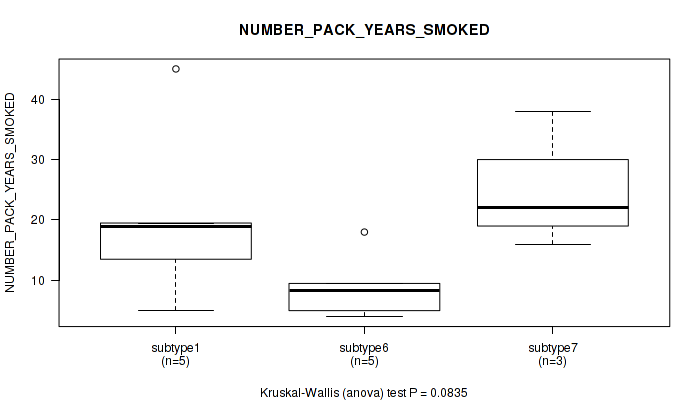
P value = 0.734 (Fisher's exact test), Q value = 0.91
Table S53. Clustering Approach #3: 'METHYLATION CHIERARCHICAL' versus Clinical Feature #16: 'SMOKER'
| nPatients | NON-SMOKER | SMOKER |
|---|---|---|
| ALL | 70 | 21 |
| subtype1 | 26 | 7 |
| subtype2 | 8 | 3 |
| subtype3 | 7 | 2 |
| subtype4 | 7 | 0 |
| subtype5 | 5 | 1 |
| subtype6 | 12 | 5 |
| subtype7 | 5 | 3 |
Figure S50. Get High-res Image Clustering Approach #3: 'METHYLATION CHIERARCHICAL' versus Clinical Feature #16: 'SMOKER'

P value = 0.947 (Fisher's exact test), Q value = 0.97
Table S54. Clustering Approach #3: 'METHYLATION CHIERARCHICAL' versus Clinical Feature #17: 'COUNTRY_OF_ORIGIN'
| nPatients | MEXICO | POLAND | UKRAINE | UNITED STATES |
|---|---|---|---|---|
| ALL | 2 | 3 | 31 | 35 |
| subtype1 | 2 | 2 | 11 | 15 |
| subtype2 | 0 | 0 | 4 | 5 |
| subtype3 | 0 | 0 | 2 | 4 |
| subtype4 | 0 | 0 | 4 | 3 |
| subtype5 | 0 | 0 | 1 | 3 |
| subtype6 | 0 | 1 | 6 | 2 |
| subtype7 | 0 | 0 | 3 | 3 |
Figure S51. Get High-res Image Clustering Approach #3: 'METHYLATION CHIERARCHICAL' versus Clinical Feature #17: 'COUNTRY_OF_ORIGIN'

-
Cluster data file = /cromwell_root/fc-8b2df640-93e1-40a2-b735-5b7a14ef6398/10d02b45-07ea-40cc-ac82-013e5f89ebb2/aggregate_clusters_workflow/b0f8dcb2-0993-4424-ad42-552c0bd1a2d5/call-aggregate_clusters/CPTAC3-UCEC-TP.mergedcluster.txt
-
Clinical data file = /cromwell_root/fc-8b2df640-93e1-40a2-b735-5b7a14ef6398/f48b4003-eaf7-47c4-8ca4-0ddbd4729902/normalize_clinical_cptac/0ea0fb0d-64a4-4204-8245-a79f52e6cd0a/call-normalize_clinical_cptac_task_1/CPTAC3-UCEC-TP.clin.merged.picked.txt
-
Number of patients = 100
-
Number of clustering approaches = 3
-
Number of selected clinical features = 17
-
Exclude small clusters that include fewer than K patients, K = 3
Resampling-based clustering method (Monti et al. 2003)
consensus non-negative matrix factorization clustering approach (Brunet et al. 2004)
For survival clinical features, the Kaplan-Meier survival curves of tumors with and without gene mutations were plotted and the statistical significance P values were estimated by logrank test (Bland and Altman 2004) using the 'survdiff' function in R
For binary clinical features, two-tailed Fisher's exact tests (Fisher 1922) were used to estimate the P values using the 'fisher.test' function in R
For multiple hypothesis correction, Q value is the False Discovery Rate (FDR) analogue of the P value (Benjamini and Hochberg 1995), defined as the minimum FDR at which the test may be called significant. We used the 'Benjamini and Hochberg' method of 'p.adjust' function in R to convert P values into Q values.